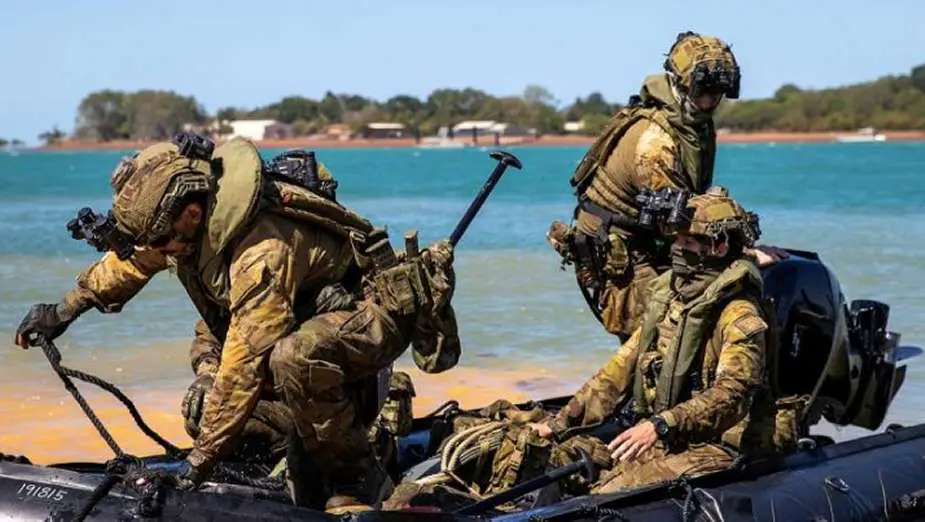Breaking news
Australian army to see major changes in units and locations.
The Australian Government has outlined key changes to the Army’s units and formations – as well as changes to equipment locations – to boost capabilities, preparedness and projection. Defence Minister Richard Marles said the changes were in response to recommendations of the Defence Strategic Review (DSR) to maintain peace, security and prosperity in the Indo-Pacific region.
Follow Army Recognition on Google News at this link

Amphibious capabilities will be boosted through changes to the Army's structure (Picture source: Sub-Lieutenant Chloe Rea /Australian MoD)
Australian Defence Minister Richard Marles said: “These changes involve some hard decisions. But these decisions are necessary to build the Army Australia needs. This will mean the Army has a concentration of people and capabilities in Australia’s north, making it easier to deploy for training, major exercises, or to support our partners and allies in the region.”
The DSR signals a shift from having a defence force with a broad range of capabilities to a more focused force directed at maintaining peace and security in the region. Accordingly, the Army is being restructured to move from generalist combat brigades to specialist combat brigades.
1st Brigade will be light, agile and quick to deploy in the littoral environment.
The 3rd Brigade will be an armoured brigade designed for amphibious operations with the Royal Australian Navy in order to secure decisive terrain. 7th Brigade will be motorised and optimised to project by air and sea to respond to regional contingencies. In summary:
• The 1st Brigade, based in Darwin, will be a light combat brigade.
• The 3rd Brigade, based in Townsville, will be an armoured combat brigade.
• The 7th Brigade, based in Brisbane, will be a motorised combat brigade.
• The 10th Brigade, based in Adelaide, will be raised as a fire brigade.
The 5th Battalion and the 7th Battalion will be relinked to become the 5th/7th Battalion, the Royal Australian Regiment, and will be based in Darwin. The 1st Armoured Regiment will be re-roled as an experimental unit to deliver and integrate emerging technologies. This will remain in Adelaide.
“The change is about organising the Army to train as we would fight and making the most of the resources we have been assigned,” Major General Vagg said. “These changes will deliver world-class, relevant and credible combat capabilities that are focused and optimised for operating in the littoral environments of our region, on land, at sea and in the air. “Our aim is to limit the disruption to our people and their families as we make these important changes. Our people are our Army and I thank each and everyone for your service and commitment to adapting our Army.”
To minimise the impact of the changes on soldiers and their families, the Army will not move personnel between regions outside of the normal posting cycles. Personnel from the 7th Battalion and 1st Armoured Regiment will post to new locations as their planned postings end, or earlier if they choose. This means most personnel will be posted in the December 2024 and January 2025 period. Acting Chief of Army Major General Richard Vagg said supporting personnel and their families would be central in the Army’s approach to implementing the changes.
The 2nd (Australian) Division – the division that commands all security and response brigades in Australia – will maintain largely part-time brigades around Australia. The Regional Force Surveillance Group will remain focused on security in northern Australia. Army Aviation and Special Operations Commands will continue on their current modernisation pathways. Army’s presence in Western Australia, Tasmania, Victoria, and NSW will be largely unaffected by the changes.
Changes to Army equipment locations:
• Townsville will become the home of armoured vehicles and army attack and medium-lift aviation. Army’s presence in Townsville will grow as a result.
• Brisbane will be home to a motorised combat brigade with a focus on the ability to uplift and move personnel.
• Darwin will see minor changes to the combat brigade, with a focus on light forces that are agile and quick to move. The number of Army personnel posted to Darwin will remain steady over time.
• Adelaide will become future-focused, where key future long-range strike capabilities will be consolidated:
- Accelerated and expanded long-range strike (HIMARS) and integrated air and missile defence capabilities (NASAMS) will be based in Adelaide.
- The number of full-time personnel in Adelaide will decrease over the short term. Numbers are expected to return to current levels from 2028.
Defense News September 2023























